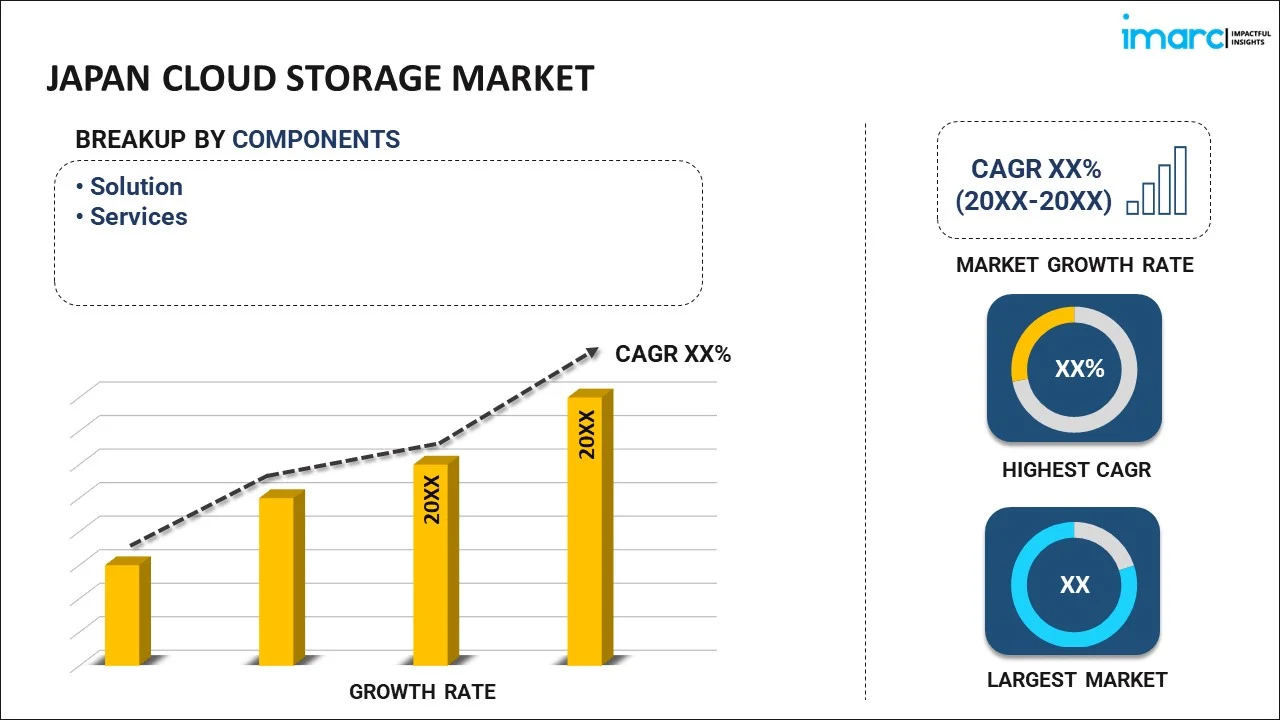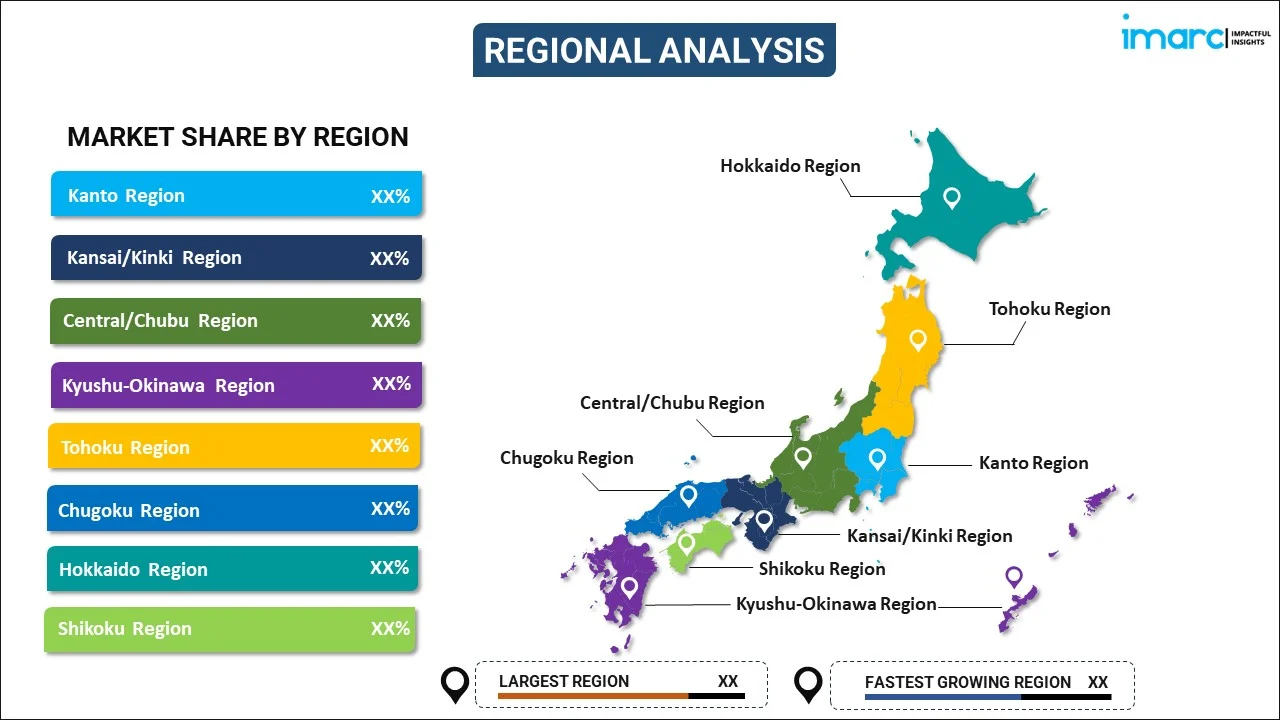
Japan Cloud Storage Market Report by Component (Solution, Services), Deployment Type (Private, Public, Hybrid), User Type (Large Enterprises, Small and Medium-sized Enterprises), Industry Vertical (BFSI, Government and Public Sector, Healthcare, IT and Telecom, Retail, Manufacturing, Media and Entertainment, and Others), and Region 2025-2033
Market Overview:
Japan cloud storage market size reached USD 6,949.6 Million in 2024. Looking forward, IMARC Group expects the market to reach USD 10,510.6 Million by 2033, exhibiting a growth rate (CAGR) of 4.70% during 2025-2033. The increasing demand for cloud services and big data analytics, the rising need for more reliable and scalable data processing and storage facilities and stringent regulatory compliance represent some of the key factors driving the market.
|
Report Attribute
|
Key Statistics
|
|---|---|
|
Base Year
|
2024 |
|
Forecast Years
|
2025-2033
|
|
Historical Years
|
2019-2024
|
| Market Size in 2024 | USD 6,949.6 Million |
| Market Forecast in 2033 | USD 10,510.6 Million |
| Market Growth Rate (2025-2033) | 4.70% |
Cloud storage refers to a cloud computing system where data is saved on distant servers and can be accessed either over the Internet or via a dedicated private network link. This storage is overseen and run by providers of cloud storage services. It provides immediate automatic backup and safeguards against theft and natural calamities, resulting in reduced expenses for server maintenance and management. Furthermore, as it presents a cost-efficient and adaptable substitute to storing files on on-site hard drives or storage networks, cloud storage is extensively employed in various sectors such as manufacturing, telecommunications, media and entertainment, and information technology (IT).
Japan Cloud Storage Market Trends:
The Japan cloud storage market is currently experiencing a notable surge in global data creation, replication, and consumption. This trend, combined with the flourishing banking, financial services, and insurance (BFSI) sector, serves as a key driving force for the market's expansion. Additionally, the healthcare industry leverages cloud storage solutions to facilitate easier access to electronic medical records (EMR), which is crucial for patient diagnosis and treatment. These solutions also ensure real-time backup of medical data, enabling healthcare providers to swiftly recover data in the event of hardware failures, power outages, or data breaches, minimizing disruptions to patient care. This, coupled with the increasing automation across various industry verticals worldwide, contributes to a positive market outlook. In recent years, the healthcare sector in Japan has particularly embraced cloud storage solutions to manage electronic medical records (EMRs) and enable efficient data sharing among healthcare providers. The benefits of real-time data backup and easy data restoration in case of system failures have contributed to the growing adoption of cloud storage solutions in the healthcare industry. Furthermore, the increased adoption of remote work due to the COVID-19 pandemic and subsequent lockdowns in different countries is propelling the market. Moreover, the growing acceptance of serverless cloud, which eliminates the need for leasing servers or paying for fixed storage amounts or bandwidth, is expected to drive market growth.
Japan Cloud Storage Market Segmentation:
IMARC Group provides an analysis of the key trends in each segment of the market, along with forecasts at the country level for 2025-2033. Our report has categorized the market based on component, deployment type, user type, and industry vertical.
Component Insights:

- Solution
- Services
The report has provided a detailed breakup and analysis of the market based on the component. This includes solution and services.
Deployment Type Insights:
- Private
- Public
- Hybrid
A detailed breakup and analysis of the market based on the deployment type have also been provided in the report. This includes private, public, and hybrid.
User Type Insights:
- Large Enterprises
- Small and Medium-sized Enterprises
The report has provided a detailed breakup and analysis of the market based on the user type. This includes large enterprises and small and medium-sized enterprises.
Industry Vertical Insights:
- BFSI
- Government and Public Sector
- Healthcare
- IT and Telecom
- Retail
- Manufacturing
- Media and Entertainment
- Others
A detailed breakup and analysis of the market based on the industry vertical have also been provided in the report. This includes BFSI, government and public sector, healthcare, IT and telecom, retail, manufacturing, media and entertainment, and others.
Regional Insights:

- Kanto Region
- Kansai/Kinki Region
- Central/ Chubu Region
- Kyushu-Okinawa Region
- Tohoku Region
- Chugoku Region
- Hokkaido Region
- Shikoku Region
The report has also provided a comprehensive analysis of all the major regional markets, which include Kanto Region, Kansai/Kinki Region, Central/ Chubu Region, Kyushu-Okinawa Region, Tohoku Region, Chugoku Region, Hokkaido Region, and Shikoku Region.
Competitive Landscape:
The market research report has also provided a comprehensive analysis of the competitive landscape. Competitive analysis such as market structure, key player positioning, top winning strategies, competitive dashboard, and company evaluation quadrant has been covered in the report. Also, detailed profiles of all major companies have been provided. Some of the key players include:
- Hitachi Vantara LLC (Hitachi Ltd.)
- Internet Initiative Japan Inc.
- KDDI Corporation
- Seagate Technology Holdings plc
- Tsukaeru.net Co. Ltd.
(Please note that this is only a partial list of the key players, and the complete list is provided in the report.)
Japan Cloud Storage Market Report Coverage:
| Report Features | Details |
|---|---|
| Base Year of the Analysis | 2024 |
| Historical Period | 2019-2024 |
| Forecast Period | 2025-2033 |
| Units | Million USD |
| Scope of the Report | Exploration of Historical and Forecast Trends, Industry Catalysts and Challenges, Segment-Wise Historical and Predictive Market Assessment:
|
| Components Covered | Solution, Services |
| Deployment Types Covered | Private, Public, Hybrid |
| User Types Covered | Large Enterprises, Small and Medium-sized Enterprises |
| Industry Verticals Covered | BFSI, Government and Public Sector, Healthcare, IT and Telecom, Retail, Manufacturing, Media and Entertainment, Others |
| Regions Covered | Kanto Region, Kansai/Kinki Region, Central/ Chubu Region, Kyushu-Okinawa Region, Tohoku Region, Chugoku Region, Hokkaido Region, Shikoku Region |
| Companies Covered | Hitachi Vantara LLC (Hitachi Ltd.), Internet Initiative Japan Inc., KDDI Corporation, Seagate Technology Holdings plc, Tsukaeru.net Co. Ltd., etc. |
| Customization Scope | 10% Free Customization |
| Post-Sale Analyst Support | 10-12 Weeks |
| Delivery Format | PDF and Excel through Email (We can also provide the editable version of the report in PPT/Word format on special request) |
Key Questions Answered in This Report:
- How has the Japan cloud storage market performed so far and how will it perform in the coming years?
- What has been the impact of COVID-19 on the Japan cloud storage market?
- What is the breakup of the Japan cloud storage market on the basis of component?
- What is the breakup of the Japan cloud storage market on the basis of deployment type?
- What is the breakup of the Japan cloud storage market on the basis of user type?
- What is the breakup of the Japan cloud storage market on the basis of industry vertical?
- What are the various stages in the value chain of the Japan cloud storage market?
- What are the key driving factors and challenges in the Japan cloud storage?
- What is the structure of the Japan cloud storage market and who are the key players?
- What is the degree of competition in the Japan cloud storage market?
Key Benefits for Stakeholders:
- IMARC’s industry report offers a comprehensive quantitative analysis of various market segments, historical and current market trends, market forecasts, and dynamics of the Japan cloud storage market from 2019-2033.
- The research report provides the latest information on the market drivers, challenges, and opportunities in the Japan cloud storage market.
- Porter's five forces analysis assist stakeholders in assessing the impact of new entrants, competitive rivalry, supplier power, buyer power, and the threat of substitution. It helps stakeholders to analyze the level of competition within the Japan cloud storage industry and its attractiveness.
- Competitive landscape allows stakeholders to understand their competitive environment and provides an insight into the current positions of key players in the market.
Need more help?
- Speak to our experienced analysts for insights on the current market scenarios.
- Include additional segments and countries to customize the report as per your requirement.
- Gain an unparalleled competitive advantage in your domain by understanding how to utilize the report and positively impacting your operations and revenue.
- For further assistance, please connect with our analysts.
 Inquire Before Buying
Inquire Before Buying
 Speak to an Analyst
Speak to an Analyst
 Request Brochure
Request Brochure
 Request Customization
Request Customization




.webp)




.webp)












